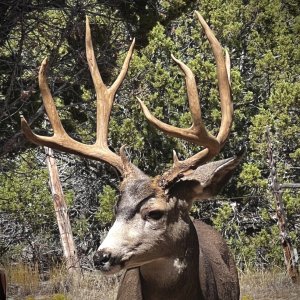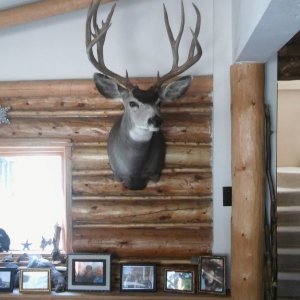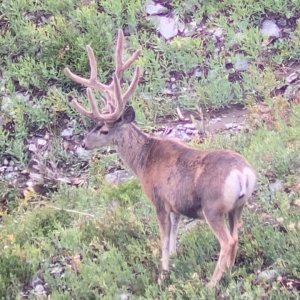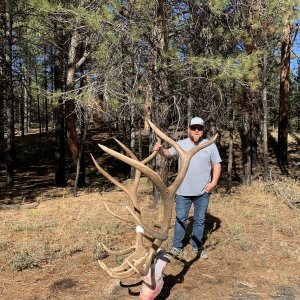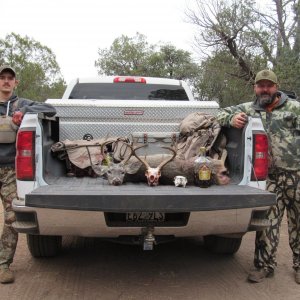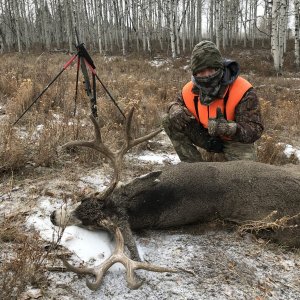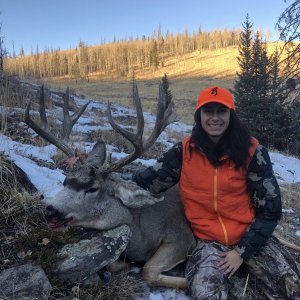You are using an out of date browser. It may not display this or other websites correctly.
You should upgrade or use an alternative browser.
You should upgrade or use an alternative browser.
What kind of bird is this?
- Thread starter Founder
- Start date
tailchasers
Long Time Member
- Messages
- 5,516
Sandhill crane. AKA fling prime rib.
desperatehills
Very Active Member
- Messages
- 1,396
ribeye in the sky
OutdoorWriter
Long Time Member
- Messages
- 8,276
Sandhills migrate all the way from northern Canada down to the deserts in AZ & elsewhere like the Bosque del Apache in NM. So you're liable to see them resting anywhere in between.
When I was hunting caribou in the NWT, we saw 1000s of them, and the same on my moose hunt in northern BC. At the latter, a big flock would stop on a tundra covered hill top & spend the night, then leave in the morning. And boy, do they make a racket, both when flying over & while feeding.


When I was hunting caribou in the NWT, we saw 1000s of them, and the same on my moose hunt in northern BC. At the latter, a big flock would stop on a tundra covered hill top & spend the night, then leave in the morning. And boy, do they make a racket, both when flying over & while feeding.
Last edited:
hornkiller
Long Time Member
- Messages
- 4,269
I've seen them at 9,000 too!
Founder
Founder Since 1999
- Messages
- 11,689
I think it was about 8500 feet. I sure didn’t expect to see them. Weird.Yes, sandhill cranes, what elevation are you at? I usually see them in hayfields or some kind if wetlands.
OutdoorWriter
Long Time Member
- Messages
- 8,276
This is what we listened to most days & many nights when I was hunting moose in northern BC.
Turn up the sound..
Turn up the sound..
DeerHunter53
Long Time Member
- Messages
- 3,267
Saw them in the Nevada desert a few years ago by Elko lots of them and they do make a lot of racket when they take off
prairie_ghost
Member
- Messages
- 29
Dark red meat like a goose. 'Ribeye in the sky' nickname is well deserved tho.Do they taste like chicken?
Bluehair
Long Time Member
- Messages
- 8,566
Um….just how big are your dogs?They will take a retrievers eye out in a hurry if they’re wounded…
gundog2
Active Member
- Messages
- 533
The Cornell Lab, All About Birds website has great information about the Sandhill crane. I assume the common name comes from the Sandhills of Nebraska, where extremely large flocks often stage during migration. I have been near large flocks where the trumpeting was overwhelming.
Last edited:
Bluehair
Long Time Member
- Messages
- 8,566
Whew….I thought you had a sandhill retriever. ?Just a regular old black lab, 85lbs fit…
highfastflyer
Very Active Member
- Messages
- 1,553
A modern teradactyl, if you hear one you will agree.
Bluehair
Long Time Member
- Messages
- 8,566
And how exactly do you know this?A modern teradactyl, if you hear one you will agree.
highfastflyer
Very Active Member
- Messages
- 1,553
The sandhill crane can be found across North America and can reach nearly 4 feet in height with a 6-foot wingspan. Between their deliberate walk, exuberant mating dance, and rattling trills, it's easy to picture one of these birds walking among the dinosaurs. Sandhill cranes are direct descendants of dinosaurs. https://paleontologyworld.com/curio...-look-eerily-similar-their-dinosaur-ancestorsAnd how exactly do you know this?
Bluehair
Long Time Member
- Messages
- 8,566
Yeah, I know what a sandhill crane is. How do you know what a pterodactyl sounds like?
The sandhill’s I’ve seen don’t look anything like the cartoons of pterodactyls people draw based on some fossils. I’m not sure of their call because I’m not an expert on reptile calls.
How about unicorn calls? What does the internet say they sound like? Braying ass?
The sandhill’s I’ve seen don’t look anything like the cartoons of pterodactyls people draw based on some fossils. I’m not sure of their call because I’m not an expert on reptile calls.
How about unicorn calls? What does the internet say they sound like? Braying ass?
Last edited:
highfastflyer
Very Active Member
- Messages
- 1,553
Scientists have studied the fossils and throat anatomy and have recreated the sounds.Yeah, I know what a sandhill crane is. How do you know what a pterodactyl sounds like?
The sandhill’s I’ve seen don’t look anything like the cartoons of pterodactyls people draw based on some fossils. I’m not sure of their call because I’m not an expert on reptile calls.
How about unicorn calls? What does the internet say they sound like? Braying ass?
highfastflyer
Very Active Member
- Messages
- 1,553
Much of it is painstakingly slow Science. Using a computer, scientists at the New Mexico Museum of Natural History have created what they believe are the sounds of the Parasaurolophus, which roamed the earth more than 70 million years ago. It took two years before the sound could be replicated by a museum palaeontologist and a scientist from the Sandia National Laboratories. Here's how they worked it out: Scientists took a three dimensional x-ray of a dinosaur skull which was unearthed in northwestern New Mexico. Then, they fed data through their computer, and calculated how the sound waves likely bounced through the 4-foot (1.3 metre) crest rising from the back of the dinosaur's head.I’m calling bullchit. But be careful out there on the internet……it’s a dangerous place for the gullible.
Bluehair
Long Time Member
- Messages
- 8,566
The NM Museum of Natural History?Much of it is painstakingly slow Science. Using a computer, scientists at the New Mexico Museum of Natural History have created what they believe are the sounds of the Parasaurolophus, which roamed the earth more than 70 million years ago. It took two years before the sound could be replicated by a museum palaeontologist and a scientist from the Sandia National Laboratories. Here's how they worked it out: Scientists took a three dimensional x-ray of a dinosaur skull which was unearthed in northwestern New Mexico. Then, they fed data through their computer, and calculated how the sound waves likely bounced through the 4-foot (1.3 metre) crest rising from the back of the dinosaur's head.
They reconstructed all that soft tissue anatomy from the imagined spatial orientation of a couple of grains of sand from a couple of million years ago? Riiiiighhhhttttt…….
Let’s apply a little critical thinking. These phony grant-sucking charlatans need to be mocked at every opportunity. They’re peddling entertainment, not science.
Have you ever met one of these academic lab rats? They can’t even match their socks in the morning.
Wait….are you one of them?
BTW, what’s your favorite reptile call? Mine would be those dragons on game of thrones if they were real. So I’m going with a rattlesnake
Last edited:
highfastflyer
Very Active Member
- Messages
- 1,553
Don’t piss off the GeckoThe NM Museum of Natural History?Is that in Hobbs?
They reconstructed all that soft tissue anatomy from the imagined spatial orientation of a couple of grains of sand from a couple of million years ago? Riiiiighhhhttttt…….
Let’s apply a little critical thinking. These phony grant-sucking charlatans need to be mocked at every opportunity. They’re peddling entertainment, not science.
Have you ever met one of these academic lab rats? They can’t even match their socks in the morning.
Wait….are you one of them?
BTW, what’s your favorite reptile call? Mine would be those dragons on game of thrones if they were real. So I’m going with a rattlesnake
notdonhunting
Very Active Member
- Messages
- 2,293
Blue
I could not agree more, scientists lie more than politicians.
I could not agree more, scientists lie more than politicians.



